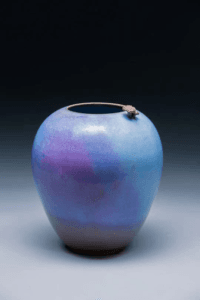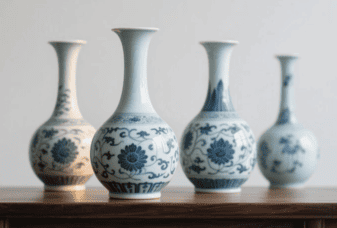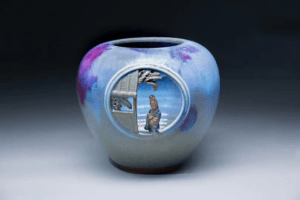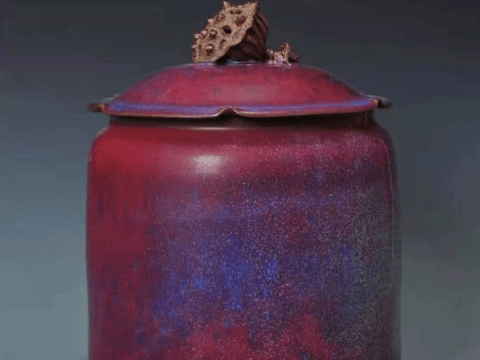Exploring the three core features of the peak aesthetics of Ming dynasty official kilns
- “This antique jargon sums up the extraordinary status of official kiln porcelains from the Chenghua period (1465-1487) of the Ming Dynasty. When people stopped at the Palace Museum Chenghua fighting color chicken bowl cup in front of the display case, or marveled at the Sotheby’s auction sold for 280 million Hong Kong dollars Chenghua blue and blue anemone pattern palace bowl, will always be as thin as a cicada’s wing of the body, beautiful and elegant pattern of the bowls convinced.
- What is it that makes these objects from 500 years ago still regarded as the standard of porcelain art? The answer is hidden in the three major aesthetic code of Chenghua porcelain.
First, the tire glaze exquisite: jade texture and the perfect unity of the magic of light and shadow
- Chenghua porcelain “glutinous rice tire” quality is known as a technical miracle in the history of Chinese porcelain. Craftsmen choose Jingdezhen makang mountain specialties “makang soil”, after dozens of washing process, the tire soil is as delicate as powder, after firing through the light can be seen slightly fleshy red, touch warm like jade. The combination of this unique texture and sweet white glaze creates the visual effect of “glistening as jade, light and shadow”.
- Chenghua white glaze pear-shaped pot, for example, its glaze presents a unique “lard white” texture, the glaze layer in the uniform distribution of tiny bubbles in the light refraction to form a hazy halo, as if covered with a layer of soft light filter. This glaze color achievement of the Chenghua porcelain “white as congealed fat, green as clouds” aesthetic characteristics, for the subsequent painting provides an excellent “canvas”.

Chenghua porcelain is the porcelain fired in the official kilns of Jingdezhen during the Chenghua period (1465-1487) of the Ming Dynasty, and is known for its light and thin body, warm glaze, and fine painting. In particular, Chenghua doucai porcelain is regarded as the pinnacle of Chinese ceramic history.
Second, the painting revolution: from the blue and white alone to fight color competition
- The most significant breakthrough in Chenghua porcelain is the mature use of color fighting process.
- Craftsmen pioneered the “fill color” technique: first in the tire with cobalt material outline, apply transparent glaze high temperature firing into blue and white porcelain, and then in the glaze with red, green, yellow and other color materials accurate filling, the second into the kiln low-temperature baking.
- This process makes the color contrast more vivid, and the expression of details reaches new heights.
The color system of Chenghua Doucai is highly recognizable:
- Purple: a unique metallic purple color that is difficult to imitate in later generations.
Goose yellow: the soft yellow of a bird’s fluff.
Fruit green: translucent green like freshly picked grapes
Alum red: a subdued and subtle iron oxide red.
This color philosophy is best shown on the Doucai Chicken Jar Cup: the alum red of the hen’s feathers contrasts with the goose yellow of the chicks, and the blue of the rocks and the green of the grass and trees builds up the spatial hierarchy, which is a porcelain rendition of miniature brush painting. - Third, the aesthetics of the vessel: from the royal weather to the literati interest in the shift
- Chenghua porcelain completely changed the Yongxuan period of thick and solemn style, creating a new paradigm of “delicate and timeless”. This is closely related to the cultural orientation of the Chenghua emperor Zhu Jishen: the emperor, who experienced the Tumubao Incident, put his desire for a peaceful life into his artistic creations.
Typical vessel features include:
- Thin tires and thick glazes: wares with an average thickness of only 0.8-1.2 millimeters maintain a perfect shape.
Curvilinear innovation: bowls with the mouth flared out at an increased angle, creating an elegant “bell-shaped” silhouette.
Exquisite proportions: the ratio of the neck height to the diameter of the belly of the Meiping vase was strictly controlled at 1:2.5, presenting a visual golden section.
Functional evolution: the emergence of furnishings dedicated to the study, such as brush washes and seal boxes, reflecting the influence of literati aesthetics.
Particularly noteworthy is the Chenghua blue and white baby play pattern bowl, its 15.3 cm caliber and 4.7 cm foot diameter constitutes a perfect parabola, the layout of the pattern of children playing sparsely and densely, showing the design wisdom of the “small ware, big kind”. - Fourth, the password of the mark: a brushstroke all hide the royal rhyme

“Daming Chenghua year system” six characters in regular script as the official kiln ID card, contains a unique era of password. The authenticity of the character can be summarized as follows:
- The fifth stroke of the character is straight down, with a slight staccato in the closing stroke.
“Made” part of the word clothing horizontal strokes do not cross the knife, the last vertical short and strong
The color of the blue-and-white mark sinks into the underglaze, and a cloud-like halo is visible in the side-light.
The layout adopts the “double-circle, double-row” style, and the spacing of the fonts is sparse and coherent.
These features are perfectly embodied in the Chenghua blue and white twining lotus pattern high-footed cup’s bottom mark, which has the sinews of the Tang Regular Script, but also has the flowing style of Zhao Mengfu’s running script, and has been hailed by posterity as “the most beautiful official kiln mark of the Ming dynasty”.
When we connect these features, we can understand why Chenghua porcelain can span five centuries and still fascinating: it is the crystallization of the trinity of material technology, artistic aesthetics, and the spirit of the times. From the rigorous selection of materials for the makura clay, to the fine outlining of the insect’s tentacles during the painter’s brushwork, to the minute-by-minute control of the fire by the kiln workers, each step of the process is characterized by the pursuit of perfection by the craftsmen. This pursuit of perfection is perhaps the most precious cultural heritage of Chenghua porcelain for future generations.



